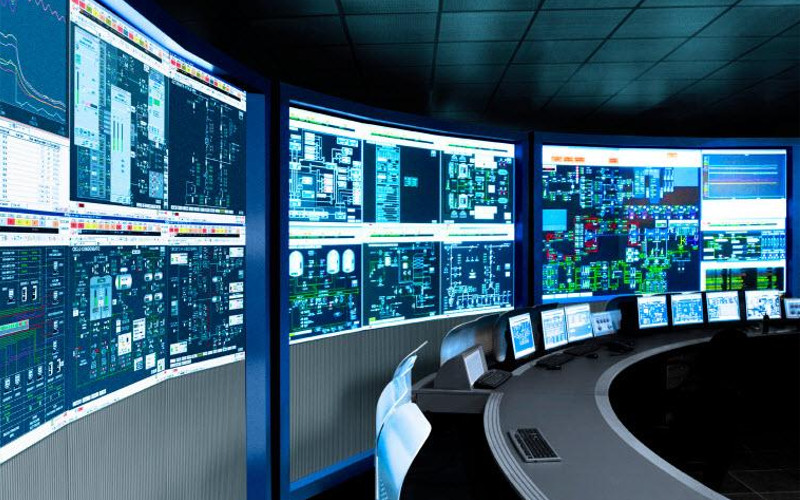Supervisory Control and Data Acquisition (SCADA) systems have been around in some form since electricity was introduced to the industrial revolution. What started as very simple warning lights and switches has grown into complex systems that can monitor and help control complex production facilities in many industries. Without functioning SCADA systems such basics as providing water and electricity in highly populated environments would be impossible.

As with most technologies, different domains and scenarios require or put more emphasis on various aspects of the technology’s functionality. This is certainly true of a SCADA system, which can be implemented in limitless ways to perform the specific tasks needed for any particular industry. In some cases, some of the system’s functionality may be more important to you than others. Let’s look at some of the specific functions that can be performed by a modern SCADA system.
Creation of a Human Machine Interface
The underlying reason for SCADA is to make complex systems more manageable by their human operators. Large production facilities that may have remote components cannot get by with a simple panel on each piece of equipment that needs to be manually inspected.
There needs to be a way to present the accumulated data gleaned from the SCADA system in a way that is understandable and usable by the human operators. In order to achieve the benefits of the rest of the SCADA system, the Human Machine Interface (HMI) is a critical component.
An HMI is comprised of a viewable device and the software that controls it. This view can be on a dedicated electronic device, a personal computer, or other connected devices. The HMI can show a complete picture of the system or subsystem being monitored, with the ability to view and respond to alerts. An HMI allows you to monitor and control a complete facility from a single centralized point. One of the problems with some legacy HMI systems is information overload at the expense of highlighting the most pertinent data.
Data Acquisition, Collection, and Storage
The acquisition, collection, and storage of data are one of the primary functions of a SCADA system. Dedicated sensors that are chosen to optimize the production facility are network connected and send data to the central system. These can be temperature gauges, electronic sensors, or a wide range of other devices that are necessary to successfully optimize the operation of the facility. It is important to have high-quality sensors to obtain the best results from your data acquisition.
This data is the foundation for the views presented in the HMI. It informs the human operators or automated software of conditions that need to be addressed. In a robust system, data will also be collected and stored after it is used in real-time. This allows for further analysis and lays the groundwork for the SCADA system to help find improvements in the industrial environment.
Monitoring
SCADA systems are meant to assist in the important task of monitoring your facility. According to automationworld.com, the ability to monitor its infrastructure with a SCADA system was critical to a water company serving over 300,000 customers. They covered over 100 remote sites that were encompassed by a 200 square mile area with all of the monitored data flowing back to the HMI screens. This enabled faster and more precise troubleshooting of faulty devices and allowed a historical record to be built allowing for proactive improvements to be made to the infrastructure.
The monitoring that your system performs can be tailored to your needs. One feature that full monitoring should include is the ability to set alarms and perform alarm logging. This can be instrumental in post-mortem analysis of problem conditions where multiple alarms may have gone off in rapid sequence. Proper logging can help determine the true origin of the problem and prevent its recurrence.
Control
Control is in the technology’s name and it is a focus of most SCADA systems. It can be as simple as turning off a faulty piece of equipment or as complex as initiating a full shutdown of your facility if the situation warrants that kind of response. Control can be effected from a remote command center without ever needing to visit the physical location of your machinery.
Power generating facilities and other utilities make use of the control capability in their SCADA systems to ensure that loads are spread evenly and spikes in usage are adequately addressed. The electronic equipment that forms the system can respond more quickly and accurately than a human operator. Oil and gas pipelines also rely heavily on the control aspects of their SCADA systems to maximize throughput. The software that runs your SCADA system can be programmed to take whatever sorts of action are required to respond to any monitoring situations you can imagine.
Report Generation
Report generation is an important piece of a complete SCADA system. All the data that is collected and stored in the operation of a facility should be available for both real-time and historical reporting. These reports are critical for the immediate use by technicians and operators and can be indispensable when searching for improvements in your production line or processes.
Reporting ties in with the HMI and should be integrated by your SCADA software. Your HMI should be able to easily produce various reports to assist in operations, planning and problem determination. The ability to view your data in different formats, such as customized graphs and charts, lends value to your SCADA system beyond keeping your operation running smoothly.
SCADA Functionality and Your Business
If you are in any kind of business that involves large-scale industrial facilities you can benefit from employing a SCADA system. As you can see from the examples of functionality we have discussed, there are many ways to harness the power of the SCADA paradigm. Taken together, the components of a SCADA system create a formidable tool with which to address the complexities of modern distributed production facilities.
Did you find this article to be helpful and informative? Leave us a comment with your thoughts in the section below.

